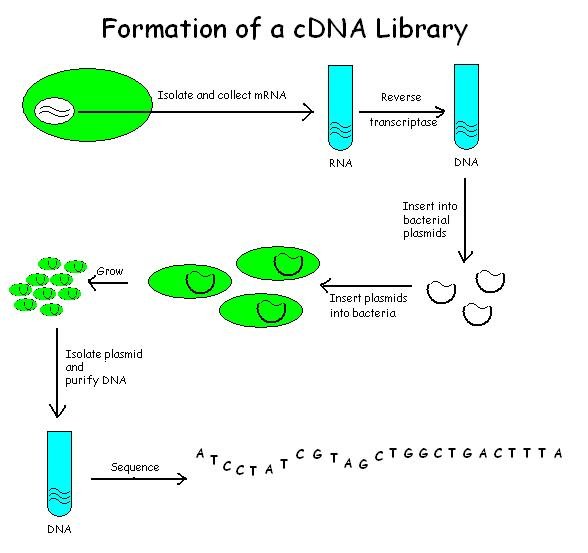cDNA Libraries
cDNA cloning is almost the same as genomic cloning (see previous post) except that the library only contains coding regions of the DNA (the structural part of genes). Genes may be cloned in order to understand the function of a gene, to mass produce a protein (eg. insulin) or to transfer a gene from one organism to another. Several steps are involved in the construction of a cDNA library:
- Isolate RNA
- Generate cDNA: To do this you have to:
- Isolate the mRNA from cells or tissue of interest using a mRNA Poly A tail
- Use dT primer and Reverse Transcriptase to synthesise a mRNA/DNA hybrid
- mRNA is degraded
- The free 3 end of the cDNA strand forms a hairpin loop that primes the synthesis of DNA using DNA Polymerase III.
- S1 nuclease cleaves the hairpin loop leaving a double stranded cDNA/DNA copy of the original mRNA
- Ligate into vector
- Introduce recombinant vector into E.coli
- Screen cDNA library for gene of interest: the library is plated out in a dish. Antibiotic is added in order to screen for the gene of interest. This is because cDNA has antibiotic resistance.
- Analysis of cDNA clones.
 |
| The Formation of a cDNA Library source:http://commons.wikimedia.org/wiki/File%3AFormation_of_a_cDNA_Library.jpg If you'd like to use this file please see this website first |
In this technique, DNA molecules are placed in wells carved out of a section of agarose or polyacrylamide gel. A positive electrode is placed on one side of the gel while a negative electrode is placed on the other side. DNA molecules are negatively charged so they migrate to the positive pole. However, large molecules migrate slower than small molecules. DNA molecules of a known size are used to monitor the progression of the gel electrophoresis and to determine the size of the DNA molecules. Specific DNA fragments can be isolated from the gel and used for further analysis.
 |
| Gel Electrophoresis source: http://commons.wikimedia.org/wiki/File%3AGel_electrophoresis_2.jpg If you'd like to use this picture please see this website first. |
Dideoxy Sequencing
This is used to sequence DNA. When DNA is being replicated, DNA polymerase requires a primer. The enzyme extends the primer by adding nucleotides to the strand of DNA. In this method, ddNTP's are added to the reaction. ddNTP's lack a 3' OH group and have a fluorescent marker. Because they lack a 3' OH group they cause the reaction to stop causing the chain of nucleotides to stop. The Polymerase Chain Reaction (PCR) is used to sequence the reaction. However only one primer is added (instead of 2 in normal PCR) and ddNTP's are added, so this process is termed Cycle Sequencing. The reaction will include:
- The DNA template
- TAQ polymerase
- A primer
- dNTP's
- ddNTP's
The reaction follows a cycle of:
- denaturation
- annealing
- extension
After many cycles have occurred there are multiple fragments of every length of DNA possible, each terminated by a ddNTP (dideoxy nucleotide). Unlike in PCR, however, there is a linear increase in the number of fragments and not a logarithmic increase.
Gel Electrophoresis is a process used to separate molecules like DNA (deoxyribonucleic acid) and RNA (ribonucleic acid) based on their size and charge. The protein molecules are enclosed in a gel and are subjected to electric current for creating movement and separation. This process is helpful to analyze the molecular components of living organisms and provide great help in Forensics field.
ReplyDeleteThis comment has been removed by the author.
ReplyDelete